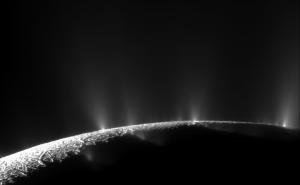Cassini is currently orbiting Saturn with a period of 13.9 days in a plane inclined 0.6 degree from the planet's equatorial plane. The most recent spacecraft tracking and telemetry data were obtained on Sept. 30 using the 70-meter diameter DSN stations in Australia.
Cassini is currently orbiting Saturn with a period of 13.9 days in a plane inclined 0.6 degree from the planet’s equatorial plane. The most recent spacecraft tracking and telemetry data were obtained on Sept. 30 using the 70-meter diameter DSN stations in Australia. The spacecraft continues to be in an excellent state of health with all of its subsystems operating normally except for the instrument issues described at http://saturn.jpl.nasa.gov/news/significantevents/anomalies .
The stored load of commands named S91 continued controlling the spacecraft and its instruments this week; the major highlight was the T-113 encounter with Saturn’s planet-like moon Titan. Among the many other T-113 scientific observations, Cassini’s mass spectrometer sampled Titan’s upper atmosphere, and the Radar team acquired a long swath of high-resolution imaging across its haze-hidden surface using synthetic-aperture radar (SAR). Cassini’s antenna has an actual aperture of four meters, but its size is amplified using high-powered computing. The software synthesizes a larger aperture as the spacecraft’s motion carries it hundreds of meters through the returning surface-echoes of pulses from the instrument’s transmitter. Since each outgoing radar pulse is tagged for recognition by the SAR software, it can be placed in the image according to its timing and Doppler shift upon return. The T-113 encounter is further described here: http://saturn.jpl.nasa.gov/mission/flybys/titan20150928 .
Back on Earth, Sequence Implementation Process teams continued to work on the 10-week sequences S92 and S93. Tasks were also scheduled for working the S94 sequence. Past S94, only seven more sequences remain to be developed; the Cassini Mission ends with its meteoric Grand Finale in S101.
Wednesday, Sept. 23 (DOY 266)
Cassini’s Composite Infrared Spectrometer (CIRS) spent 12 hours collecting infrared spectra that reveal the constituents in Saturn’s atmosphere. While CIRS controlled pointing, the Visible and Infrared Mapping Spectrometer (VIMS) obtained data while riding along. When this was completed, the Imaging Science Subsystem (ISS) took 45 minutes to look for objects orbiting near the planet, in a satellite-orbit-campaign observation with VIMS riding along.
Thursday, Sept. 24 (DOY 267)
ISS, CIRS and VIMS made a 90-minute Titan monitoring observation, while the huge moon was 2.5 million km from the spacecraft. VIMS next turned to observe Saturn’s sparse E ring and G ring for 16.5 hours, while they were sunlit from a phase angle of 105 degrees. Following this observation, ISS watched for an hour while Saturn’s small but active moon Enceladus transited across the face of larger Tethys. This illustration shows the viewing geometry for the event: https://space.jpl.nasa.gov/cgi-bin/wspace?tbody=602&vbody=-82&month=9&day=24&year=2015&hour=21&minute=30&fovmul=1&rfov=0.5&bfov=30&brite=1&showsc=1&showac=1 .
Finally, ISS led VIMS in a satellite-orbit observation one hour in duration.
Friday, Sept. 25 (DOY 268)
After commands in S91 turned Cassini to point its high-gain antenna to Earth early today, the flight team uplinked commands to execute Orbit Trim Maneuver (OTM)-21. In response, the spacecraft turned and fired its small monopropellant-fed rocket thrusters for 16 seconds. This resulted in a change in velocity of 21 millimeters per second, adjusting the trajectory on approach to the T-113 encounter.
When the OTM was finished, the Cosmic Dust Analyzer (CDA) took control and made measurements of dust orbiting Saturn in the retrograde direction. The observation lasted 14.5 hours.
Saturday, Sept. 26 (DOY 269)
ISS, CIRS and VIMS performed another 90-minute Titan monitoring observation while Titan was 1.3 million km away. Following this, the Ultraviolet Imaging Spectrograph (UVIS) studied Saturn’s aurora for nine hours, with CIRS and VIMS riding along.
Sunday, Sept. 27 (DOY 270)
With Cassini closing in on Titan, ISS monitored it for nine hours to track any clouds that might be forming in the hazy atmosphere. VIMS rode along to observe the evolution of Titan’s south polar vortex, mapped the tropical regions of Shangri-La, and looked for formation of clouds at high northern latitudes. By the day’s end, Cassini was within about 431,000 km from the giant moon, not much farther than our Earth’s Moon was from us during this evening’s “supermoon” eclipse.
Monday, Sept. 28 (DOY 271)
Today’s targeted flyby of Titan, T-113 at 1,036 km above the surface, was close enough to sense the atmosphere. Inbound, the Ion and Neutral Mass Spectrometer (INMS) took the reins and used a newly programmed mode to measure ions, charged atoms, outflowing from Titan. At closest approach, although Radar was in the driver’s seat obtaining SAR imaging data, INMS was well situated for measuring neutral atoms. INMS took over control of spacecraft pointing again on the outbound leg, and measured both charged and neutral species. See the link called out above for more on the encounter.
The gravity-assist impulse obtained during today’s flyby was used to shorten Cassini’s orbit period from 21.8 days to 13.9 days; the orbit’s inclination changed by only two-tenths of a degree.
In an image featured today, Saturn and Titan show similar-appearing atmospheres, though they are very different in nature: /resources/16245 .
Tuesday, Sept. 29 (DOY 272)
All eyes were on the Deep Space Network (DSN) as Cassini’s radio signal arrived today. The 70-meter aperture DSN station at Goldstone, California, was pointing to Saturn when the continuous signal started coming in. Tracking the signal’s Doppler shift, along with data from the ranging system, will go towards forming navigation solutions and plans for the next firing of Cassini’s rocket(s). Phase-modulated onto the same signal were the bits, the binary digits zero and one. Nine hours of decoding wiggles in the signal’s phase produced roughly 500 megabytes of telemetry data from the T-113 scientific observations, every bit faithfully captured across 1,578,000,000 km of interplanetary space.
CIRS continued monitoring Titan for some fifteen hours, looking for seasonal change in the stratosphere. ISS, VIMS, and UVIS rode along at various times. ISS imaged Titan’s surface and atmosphere over the Senkyo region on the night-side, and VIMS observed the northern pole area.
ISS conducted eight Saturn storm-watch observations this week; VIMS rode along with two of them; all were two-minute observations, squeezed in while the instruments were already pointing on or near Saturn.
During the week, the Deep Space Network communicated with and tracked Cassini on eight occasions, using DSN stations in California and Australia. A total of 1,091 individual commands were uplinked, and about 1,757 megabytes of telemetry data were downlinked and captured at rates as high as 110,601 bits per second.
This illustration shows Cassini’s position on Sept. 29: http://go.nasa.gov/1LhJogS . The format shows Cassini’s path over most of its current orbit up to today; looking down from the north, all depicted objects revolve counter-clockwise, including Saturn along its orange-colored orbit of the Sun.
































